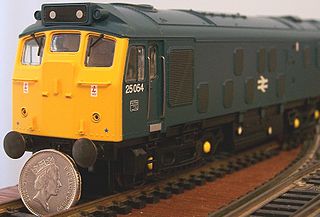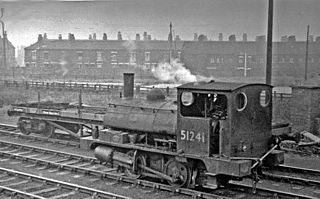
OO gauge or OO scale is the most popular standard gauge model railway standard in the United Kingdom, outside of which it is virtually unknown. OO gauge is one of several 4 mm-scale standards, and the only one to be marketed by major manufacturers. The OO track gauge of 16.5 mm corresponds to prototypical gauge of 4 ft 1+1⁄2 in, rather than 4 ft 8+1⁄2 in standard gauge. However, since the 1960s, other gauges in the same scale have arisen—18.2 mm (EM) and 18.83 mm (Scalefour)—to reflect the desire of some modellers for greater scale accuracy.

Airfix is a British brand and former manufacturing company which produced injection-moulded plastic scale model kits. In the UK, the name 'Airfix' has become practically synonymous with plastic models of this type, "they became a sort of generic name for any plastic, injection-moulded model kit".

Hornby Hobbies Limited is a British-owned scale model manufacturing company which has been focused on model railways. Its roots date back to 1901 in Liverpool, when founder Frank Hornby received a patent for his Meccano construction toy. The first clockwork train was produced in 1920. In 1938, Hornby launched its first OO gauge train. In 1964, Hornby and Meccano were bought by their competitor, Tri-ang Railways, and sold when Tri-ang went into receivership. Hornby Railways became independent again in the 1980s, and became listed on the London Stock Exchange, but due to financial troubles reported in June 2017, became majority owned by British turnaround specialist Phoenix Asset Management.

The British Railways Standard Class 9F2-10-0 is a class of steam locomotive designed for British Railways by Robert Riddles. The Class 9F was the last in a series of standardised locomotive classes designed for British Railways during the 1950s, and was intended for use on fast, heavy freight trains over long distances. It was one of the most powerful steam locomotive types ever built for British Railways, and successfully performed its intended duties. The 9F class was given the nickname of 'Spaceship', due to its size and shape.

The Great Western Railway 3700 Class, or City Class, locomotives were a series of twenty 4-4-0 steam locomotives, designed for hauling express passenger trains.

English Electric DP1, commonly known as Deltic, is a prototype 3,300 hp (2,500 kW) demonstrator locomotive employing two Napier Deltic engines, built by English Electric in 1955.

The BR Standard Class 4 2-6-0 is a class of steam locomotive designed by Robert Riddles for British Railways (BR). 115 locomotives were built to this standard.

Graham Farish is a Chinese-owned brand of N gauge British railway models. The Graham Farish Ltd company was founded in 1928 in the UK and Kader Group of Hong Kong bought the firm in 2001. Kader's subsidiary, Bachmann Industries absorbed its operations and the models are made in China.
Dapol Ltd is a model railway manufacturer based in Chirk, Wales. The factory where some of the design and manufacturing take place is just over the border in England. The company is known for its model railway products in N gauge, OO gauge and O gauge.

The London, Midland and Scottish Railway (LMS) Royal Scot Class is a class of 4-6-0 express passenger locomotive introduced in 1927. Originally having parallel boilers, all members were later rebuilt with tapered type 2A boilers, and were in effect two classes.

The London, Midland and Scottish Railway (LMS) Garratt was a class of Garratt 2-6-0+0-6-2 steam locomotive designed for heavy freight. A total of 33 were built from 1927, making them the most numerous class of Garratt in Britain.

The SR V class, more commonly known as the Schools class, is a class of steam locomotive designed by Richard Maunsell for the Southern Railway. The class was a cut down version of his Lord Nelson class but also incorporated components from Urie and Maunsell's LSWR/SR King Arthur class. It was the last locomotive in Britain to be designed with a 4-4-0 wheel arrangement, and was the most powerful class of 4-4-0 ever produced in Europe. All 40 of the class were named after English public schools, and were designed to provide a powerful class of intermediate express passenger locomotive on semi-fast services for lines which could cope with high axle loads but some of which had short turntables.

The Great Western Railway (GWR) 2884 Class is a class of 2-8-0 steam locomotive. They were Collett's development of Churchward's earlier 2800 Class and are sometimes regarded as belonging to that class.

The Hunslet Austerity 0-6-0ST is a class of steam locomotive designed by Hunslet Engine Company for shunting. The class became the standard British shunting locomotive during the Second World War, and production continued until 1964 at various locomotive manufacturers.

The London and North Eastern Railway (LNER) J94 Class is a class of steam locomotive that was formed when 75 former "Austerity" 0-6-0STs were purchased by the LNER in 1946 from the War Department.

The London, Midland and Scottish Railway (LMS) Fowler 3F0-6-0T is a class of steam locomotives, often known as Jinty. They represent the ultimate development of the Midland Railway's six-coupled tank engines. They could reach speeds of up to 60 mph (97 km/h).

The London, Midland and Scottish Railway (LMS) Fowler Class 4F is a class of 0-6-0 steam locomotive designed for medium freight work. They represent the ultimate development of Midland Railway's six coupled tender engines. Many trainspotters knew them as "Duck Sixes", a nickname derived from their wheel arrangement.

The GWR 6100 Class is a class of 2-6-2T side tank steam locomotives.

The L&YR Class 21 is a class of small 0-4-0ST steam locomotive built by the Lancashire and Yorkshire Railway for shunting duties. They were nicknamed Pugs.
The Great Central Railway (Nottingham) (formerly known as the Nottingham Heritage Railway) is a heritage railway located at the Nottingham Transport Heritage Centre (NTHC), on the south side of the village of Ruddington, in Nottinghamshire. The route consists of almost 10 miles (16 km) of the former Great Central Main Line from Loughborough South Junction (with the Midland Main Line) to Fifty Steps Bridge and the site of Ruddington's former GCR station, plus a branch line from Fifty Steps Bridge to Ruddington Fields station which is located on a former Ministry of Defence site next to Rushcliffe Country Park.


















